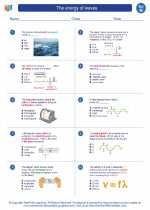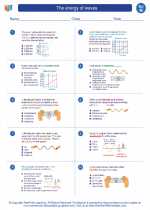The Energy of Waves
Waves are a form of energy transfer, and they can carry energy from one place to another without carrying matter along with them. There are different types of waves, including mechanical waves (such as sound waves and seismic waves) and electromagnetic waves (such as light and radio waves). The energy of waves is an important concept in understanding various natural phenomena and technological applications.
Types of Waves
There are several types of waves, including:
- Mechanical waves: These waves require a medium to travel through, such as water waves and sound waves.
- Electromagnetic waves: These waves can travel through a vacuum and do not require a medium, such as light waves and radio waves.
Energy Transfer in Waves
When a wave travels through a medium, it carries energy with it. The energy of a wave is related to its amplitude (the height of the wave) and frequency (the number of waves passing a point per unit time). The greater the amplitude and frequency of a wave, the more energy it carries.
Calculating Wave Energy
The energy of a wave can be calculated using the formula:
E = h*f
Where E is the energy of the wave, h is the Planck's constant, and f is the frequency of the wave.
Applications of Wave Energy
The energy carried by waves has various practical applications, including:
- Renewable energy: Wave energy can be harnessed to generate electricity through wave power plants.
- Communication: Electromagnetic waves are used for wireless communication, including radio, television, and mobile phones.
- Medical imaging: X-rays and ultrasound waves are used in medical imaging techniques to diagnose and treat medical conditions.
Study Guide
Here are some key points to remember about the energy of waves:
- Waves are a form of energy transfer, and they can carry energy without carrying matter.
- There are different types of waves, including mechanical waves and electromagnetic waves.
- The energy of a wave is related to its amplitude and frequency.
- Wave energy can be calculated using the formula E = h*f.
- Wave energy has various practical applications in renewable energy, communication, and medical imaging.






